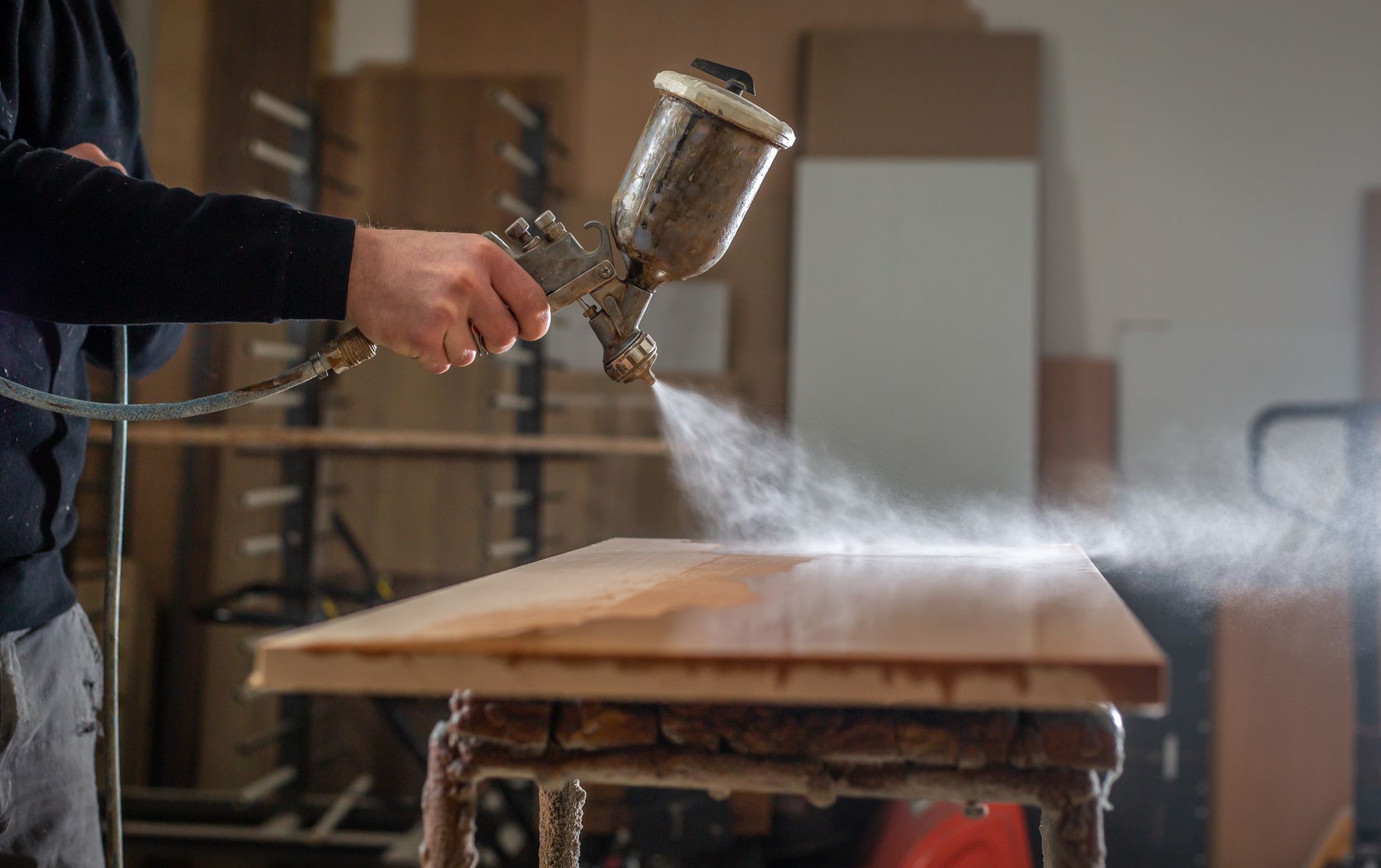Wood manufacturing has been around for centuries and has seen numerous changes and advancements over time. The digital age has brought about significant changes to the way wood manufacturing is conducted, and this has had a significant impact on the industry. In this blog, we will explore the impact of the digital age on wood manufacturing, and its history.

This article covers the following:
- History of Wood Manufacturing
- Early Wood Manufacturing
- Industrial Revolution & Wood Manufacturing
- Recent Developments in Wood Manufacturing
- Future of Wood Manufacturing
- New Technologies in Wood Manufacturing
- Automation & Robotics in Wood Manufacturing
- Sustainable Wood Manufacturing
- The Impact of the Digital Age on Wood Manufacturing
- How can Deskera assist you?
History of Wood Manufacturing
Wood manufacturing has been around for centuries and is a practice rooted in both tradition and innovation. From ancient times to the modern day, wood manufacturing has been used to create a variety of items, from furniture to tools.
As technology has advanced, so have the techniques used in wood manufacturing, allowing for more intricate and precise pieces. In this blog, we’ll explore the history of wood manufacturing and its evolution over the years.
Wood manufacturing dates back to ancient times when the first civilizations began using tools to shape wood for construction and other purposes. Ancient Egyptians used wood for building homes, boats, and furniture, as well as for making tools and weapons.
The ancient Greeks used a variety of woods, including olive, pine, and cypress, to create furniture, tools, and weapons. In the Middle Ages, woodworking became a major industry in Europe.
During this time, woodworking guilds were formed, giving woodworkers the opportunity to hone their craft and create intricate pieces. This period saw the development of many of the tools and techniques used in modern woodworking, such as mortise and tenon joints, saws, and chisels.
The Renaissance was an important period for wood manufacturing, as it saw the emergence of highly skilled artisans and craftsmen who used complex tools and techniques to create works of art.
During this time, wood was used for everything from furniture and cabinetry to musical instruments and sculptures. The Industrial Revolution saw the emergence of new woodworking technologies and advancements in wood manufacturing.
The invention of the steam engine in the 18th century allowed for larger and more precise pieces to be created, while the development of woodworking machinery allowed for the mass production of wood items.
Today, wood manufacturing is still a major industry, with a variety of techniques used to create everything from furniture to musical instruments. With modern technology, woodworkers are able to craft highly detailed pieces with precise measurements and shapes.
From traditional joinery techniques to laser cutting and 3D printing, woodworking continues to evolve and expand. Wood manufacturing has been around for centuries and continues to be an important part of our lives.
Its history reveals the evolution of woodworking techniques from ancient times to the modern day, and its future holds exciting possibilities for woodworkers around the world.
Early Wood Manufacturing
Wood is one of the most versatile materials used in manufacturing, and its history stretches back centuries. Early wood manufacturing dates back to prehistoric times and has evolved over the years as technology has advanced.
Today, wood is used in a variety of industries, from furniture and construction to musical instruments and toys. In prehistoric times, wood was used as a material for tools, weapons, and shelter.
Ancient humans crafted tools from wood, such as spears, knives, and axes. They also used wood to build rudimentary shelters, such as huts, tents, and tepees. As technology advanced, more complex tools, such as saws, drills, and lathes, were developed to shape wood into different shapes.
During the Middle Ages, wood was used extensively in construction, furniture making, and boat building. Woodworkers had to rely on their own tools and techniques to shape wood into the desired shapes.
This included using planes, chisels, and saws to create detailed designs. Woodworking was an important skill and was often passed down from generation to generation. By the 18th century, wood was being used to manufacture a variety of items.
The Industrial Revolution saw the development of new machines that could mass-produce wooden items. This allowed for larger production runs and faster delivery times. Today, wood manufacturing is still a thriving industry.
Wood is used to make furniture, musical instruments, toys, and other products. Woodworking is still a skill that is passed down from generation to generation, and many people still rely on their own tools and techniques to shape wood into the desired design.
Wood manufacturing has come a long way since prehistoric times, and it continues to evolve as technology advances. Wood remains a popular choice for furniture, construction, and a variety of other applications. With its versatility and durability, it’s easy to see why wood remains a popular choice for many manufacturers.
Industrial Revolution & Wood Manufacturing
The Industrial Revolution was a significant period of human history that transformed the way we produce goods and changed our society forever. One of the most important areas that the Industrial Revolution affected was wood manufacturing. In this blog, we will explore the impact of the Industrial Revolution on wood manufacturing and how it transformed the industry.
Before the Industrial Revolution, wood manufacturing was a manual process that required skilled craftsmen to work with hand tools to create products. This meant that wood manufacturing was slow, inefficient, and expensive. Additionally, the availability of wood was limited, as it could only be obtained from nearby forests.
However, with the advent of the Industrial Revolution, the wood manufacturing industry was revolutionized. New machinery and techniques were introduced that allowed wood to be processed faster, more efficiently, and at a lower cost. This revolutionized the industry and made wood products more accessible to the masses.
One of the most significant developments in wood manufacturing during the Industrial Revolution was the invention of the circular saw. The circular saw allowed wood to be cut more quickly and accurately than ever before. This invention revolutionized the industry and allowed manufacturers to produce wood products on a massive scale.
Another important development in wood manufacturing during the Industrial Revolution was the invention of steam-powered machinery. Steam engines allowed manufacturers to power their machines and tools, which greatly increased the efficiency of the manufacturing process. This innovation allowed for greater output of wood products, which meant that more people had access to them at a lower cost.
The development of the steam engine also led to the creation of new transportation systems, which allowed wood to be transported from distant forests to manufacturing centers. This meant that wood could be obtained from a wider range of sources, which increased the availability of wood products.
One of the most significant innovations in wood manufacturing during the Industrial Revolution was the creation of plywood. Plywood is a type of engineered wood that is made by gluing thin layers of wood together. This process allowed for wood to be used more efficiently, as it created a stronger and more durable material than solid wood.
The Industrial Revolution had a profound impact on wood manufacturing. It allowed wood products to be produced on a massive scale, which made them more accessible to the masses.
Additionally, the development of new technologies and techniques revolutionized the industry and allowed manufacturers to create wood products that were stronger, more durable, and more efficient than ever before. Today, the wood manufacturing industry continues to evolve and innovate, building on the foundations laid by the Industrial Revolution.
Recent Developments in Wood Manufacturing
Wood has been used as a building material for centuries, and as technology has advanced, so has the ability to manufacture wood products. In recent years, there have been significant developments in wood manufacturing, driven by the need for more sustainable and environmentally friendly building materials. In this blog, we will discuss some of the most significant recent developments in wood manufacturing.
Cross-Laminated Timber (CLT)
Cross-laminated timber (CLT) is a new type of engineered wood product that has been gaining popularity in recent years. It is made by gluing layers of lumber together in a crosswise pattern, with each layer at a 90-degree angle to the previous one.
This creates a strong, stable, and durable product that can be used for a wide range of applications, from building construction to furniture. CLT is also environmentally friendly, as it is made from sustainably harvested wood and has a lower carbon footprint than traditional building materials like steel and concrete.
Mass Timber
Mass timber is another new type of engineered wood product that has gained popularity in recent years. It is made by combining several layers of lumber into large, solid panels or beams.
This creates a product that is strong, stable, and fire-resistant, making it an excellent choice for high-rise building construction. Like CLT, mass timber is also environmentally friendly, as it is made from sustainably harvested wood and has a lower carbon footprint than traditional building materials.
Digital Fabrication
Digital fabrication is a new technology that is changing the way wood products are manufactured. It involves using computer-controlled machines to precisely cut and shape wood products, making it possible to create complex shapes and designs with a high degree of accuracy. This technology has been used to create everything from furniture to building components, and it is helping to revolutionize the wood manufacturing industry.
3D Printing
3D printing is another technology that is changing the way wood products are manufactured. It involves using a computer-controlled machine to create a three-dimensional object from a digital model. While 3D printing is not commonly used to manufacture wood products, it has the potential to revolutionize the industry by allowing for the creation of complex shapes and designs that would be difficult or impossible to achieve using traditional manufacturing methods.
Adhesives and Coatings
Advancements in adhesive and coating technology have also had a significant impact on wood manufacturing in recent years. New adhesives have been developed that are stronger and more durable than traditional adhesives, making it possible to create more robust and long-lasting wood products.
Coatings have also been developed that can protect wood products from moisture, UV rays, and other environmental factors, helping to extend their lifespan and reduce the need for maintenance.
In conclusion, recent developments in wood manufacturing have been driven by the need for more sustainable and environmentally friendly building materials. Cross-laminated timber, mass timber, digital fabrication, 3D printing, and advancements in adhesives and coatings are just a few of the significant advancements that have been made in the industry. These developments are helping to create a more sustainable and innovative wood manufacturing industry that can meet the needs of the future.
Future of Wood Manufacturing
Wood manufacturing has been an important part of human civilization for thousands of years. From building homes to making furniture, wood has been an essential material for human progress.
In recent years, wood manufacturing has undergone significant changes due to advancements in technology, environmental concerns, and changing consumer preferences. In this blog, we will discuss the future of wood manufacturing and the trends that will shape the industry in the coming years.
Sustainable wood sourcing
As concerns about deforestation and climate change grow, sustainable wood sourcing has become a key issue in the wood manufacturing industry. Many companies are now focusing on using wood from certified sustainable sources, such as the Forest Stewardship Council (FSC), which ensures that the wood is harvested responsibly and does not contribute to deforestation. In the future, we can expect more wood manufacturers to adopt sustainable sourcing practices, and consumers will increasingly demand products made from sustainable wood.
Digital manufacturing
Digital manufacturing, which involves using computer-aided design (CAD) and computer-aided manufacturing (CAM) software to automate the production process, is transforming the wood manufacturing industry.
This technology allows manufacturers to produce wood products with greater precision and efficiency, reducing waste and improving product quality. In the future, we can expect digital manufacturing to become even more prevalent in the wood manufacturing industry, with more companies adopting advanced robotics and artificial intelligence to automate their production processes.
Mass customization
Mass customization, which involves producing custom-made products on a large scale, is becoming increasingly popular in the wood manufacturing industry. With advances in digital manufacturing technology, it is now possible to produce customized wood products quickly and efficiently without sacrificing quality or cost. In the future, we can expect more wood manufacturers to adopt mass customization strategies, allowing consumers to customize their products to meet their specific needs and preferences.
Innovative wood products
Innovative wood products, such as cross-laminated timber (CLT) and laminated veneer lumber (LVL), are revolutionizing the wood manufacturing industry. These products are made by bonding layers of wood together, creating a strong, lightweight material that can be used in a variety of applications, from building construction to furniture making.
In the future, we can expect more innovation in the wood manufacturing industry, with companies developing new and innovative wood products that are stronger, lighter, and more sustainable.
Circular economy
The circular economy, which aims to minimize waste and maximize resource efficiency, is becoming increasingly important in the wood manufacturing industry.
Many companies are now adopting circular economy principles, such as recycling and reusing wood waste, to reduce their environmental impact and improve their bottom line.
In the future, we can expect the circular economy to become even more prevalent in the wood manufacturing industry, with more companies adopting closed-loop systems to minimize waste and maximize resource efficiency.
In conclusion, the future of wood manufacturing looks bright, with sustainable sourcing, digital manufacturing, mass customization, innovative wood products, and the circular economy all set to play an increasingly important role.
As technology continues to evolve and consumer preferences change, we can expect the wood manufacturing industry to adapt and innovate, creating new opportunities for growth and progress.
Automation & Robotics in Wood Manufacturing
Automation and robotics have revolutionized the wood manufacturing industry, increasing efficiency, reducing costs, and improving product quality. From sawmills to furniture factories, wood processing plants are increasingly adopting automated and robotic systems to streamline their operations and stay competitive in the market.
In this blog, we will explore the applications of automation and robotics in wood manufacturing, their benefits, and some examples of how these technologies are being used in the industry.
Applications of Automation and Robotics in Wood Manufacturing:
- Sawmills: In sawmills, automation and robotics are used to optimize the cutting process, increasing yield and reducing waste. Automated saws can quickly and accurately cut logs into boards, while robots can sort and stack the lumber for further processing.
- Panel Production: Automated systems are used in the production of engineered wood products such as plywood and particleboard. These systems can precisely measure and cut the wood components, ensuring consistent product quality and reducing waste.
- Furniture Manufacturing: Robotics is increasingly being used in furniture manufacturing to handle tasks such as sanding, drilling, and painting. This improves efficiency, reduces labor costs, and improves product quality.
- Packaging and Shipping: Automated systems are used for packaging and shipping wood products. These systems can stack and wrap products on pallets, reducing the need for manual labor and improving efficiency.
Benefits of Automation and Robotics in Wood Manufacturing
- Increased Efficiency: Automation and robotics can work around the clock, improving production efficiency and reducing the need for manual labor.
- Improved Product Quality: Automated systems can perform tasks with precision and consistency, improving the quality of wood products.
- Reduced Waste: Automated systems can optimize the cutting and processing of wood products, reducing waste and improving yield.
- Reduced Labor Costs: By automating repetitive and labor-intensive tasks, wood manufacturers can reduce labor costs and improve profitability.
Examples of Automation and Robotics in Wood Manufacturing
- Stiles Machinery: Stiles Machinery, a manufacturer of woodworking equipment, uses robotics in its panel processing machines to improve efficiency and reduce labor costs.
- Biesse Group: Biesse Group, an Italian manufacturer of woodworking machinery, offers a range of automated systems for furniture manufacturing, including robots for sanding and painting.
- Weyerhaeuser: Weyerhaeuser, one of the largest manufacturers of wood products in the world, uses automated saws and sorting systems in their sawmills to optimize the cutting process and reduce waste.
- IKEA: IKEA, the world's largest furniture retailer, is exploring the use of robots in furniture manufacturing to improve efficiency and reduce costs.
Automation and robotics have transformed the wood manufacturing industry, improving efficiency, reducing costs, and improving product quality. From sawmills to furniture factories, wood processing plants are increasingly adopting automated and robotic systems to streamline their operations and stay competitive in the market. As technology continues to advance, we can expect to see even more innovative applications of automation and robotics in wood manufacturing.
Sustainable Wood Manufacturing
Sustainable wood manufacturing is an approach to producing wood products in a way that minimizes negative impacts on the environment while also promoting the economic and social well-being of communities that depend on the industry. This blog will delve into what sustainable wood manufacturing is, why it's important, and how it can be achieved.
What is Sustainable Wood Manufacturing?
Sustainable wood manufacturing is the process of producing wood products in a way that meets the needs of the present without compromising the ability of future generations to meet their own needs. This involves balancing economic, social, and environmental factors to ensure that wood production is sustainable in the long term.
Why is Sustainable Wood Manufacturing Important?
Sustainable wood manufacturing is important for several reasons:
- Conservation of Forests: Forests are vital to the health of our planet as they absorb carbon dioxide, release oxygen, and support biodiversity. Sustainable wood manufacturing ensures that forests are not overexploited and are protected for future generations.
- Climate Change Mitigation: Sustainable wood manufacturing can help mitigate climate change by reducing carbon emissions from forest loss and degradation, and by producing wood products that sequester carbon.
- Economic Development: The wood industry provides jobs and income for millions of people around the world, particularly in rural areas. Sustainable wood manufacturing can help ensure that these communities have long-term economic opportunities.
- Social Responsibility: Sustainable wood manufacturing ensures that communities that depend on the industry are treated fairly and that their rights and livelihoods are protected.
How can Sustainable Wood Manufacturing be Achieved?
Sustainable wood manufacturing can be achieved through a combination of policies, practices, and certifications:
- Forest Certification: Forest certification programs such as the Forest Stewardship Council (FSC) and the Programme for the Endorsement of Forest Certification (PEFC) provide independent verification that forests are managed sustainably.
- Sustainable Forestry Practices: Sustainable forestry practices such as reduced-impact logging, reforestation, and protection of high conservation value forests can help ensure that forests are managed in a way that is ecologically sustainable.
- Responsible Sourcing: Responsible sourcing involves sourcing wood products from sustainable sources and ensuring that the entire supply chain is transparent and environmentally and socially responsible.
- Recycling and Reuse: Recycling and reusing wood products can help reduce the demand for virgin wood and extend the life of wood products.
Sustainable wood manufacturing is essential for the health of our planet, the well-being of communities that depend on the industry, and the long-term economic viability of the wood industry.
Achieving sustainable wood manufacturing requires a commitment to responsible forestry practices, responsible sourcing, and recycling and reuse of wood products. By working together, we can ensure that the wood industry continues to provide essential products while also protecting the environment and promoting social and economic well-being.
The Impact of the Digital Age on Wood Manufacturing
Wood manufacturing has been around for centuries and has seen numerous changes and advancements over time. The digital age has brought about significant changes to the way wood manufacturing is conducted, and this has had a significant impact on the industry. In this blog, we will explore the impact of the digital age on wood manufacturing.
Increased Efficiency
One of the most significant impacts of the digital age on wood manufacturing is the increased efficiency of production processes. The use of computer-aided design (CAD) software and computer numerical control (CNC) machines has made it possible to automate many of the manufacturing processes. This automation has significantly reduced the time it takes to manufacture wooden products while improving the accuracy of the final products.
Improved Precision and Quality
With the use of CAD software and CNC machines, wood manufacturing has become more precise and of higher quality. These machines can make cuts and shapes with incredible accuracy, resulting in more precise products that are of higher quality. This accuracy also means that there is less waste during production, reducing costs and making the manufacturing process more environmentally friendly.
Increased Customization
The digital age has made it possible for wood manufacturers to offer more customization options to their customers. With the use of CAD software, customers can design and visualize their custom wooden products before they are manufactured. This customization has led to more personalized and unique products, which has helped manufacturers stand out in a highly competitive market.
Improved Inventory Management
The use of digital tools has also improved inventory management in wood manufacturing. With the use of inventory management software, manufacturers can track their inventory in real time, reducing the risk of overstocking or stockouts. This has helped to reduce costs and increase profitability in the industry.
Improved Safety
The digital age has also brought about improvements in safety in wood manufacturing. CNC machines can perform dangerous tasks that were previously performed by humans, reducing the risk of injury. Additionally, CAD software can simulate manufacturing processes, allowing manufacturers to identify potential safety hazards before they occur.
Increased Sustainability
Sustainability has become a significant concern in the wood manufacturing industry, and the digital age has helped to address this issue. With the use of CAD software, manufacturers can optimize the use of raw materials, reducing waste and improving sustainability. Additionally, the use of CNC machines has reduced the need for manual labor, which has led to a decrease in carbon emissions.
In conclusion, the digital age has had a significant impact on the wood manufacturing industry, improving efficiency, precision, quality, customization, inventory management, safety, and sustainability. As technology continues to advance, we can expect to see even more changes in the industry, leading to further improvements in manufacturing processes and products.
How Can Deskera Assist You?
As a manufacturer, you must keep track of your inventory stock. The condition of your inventory has a direct impact on production planning. It also has a direct impact on people and machinery use and capacity utilization.

Deskera MRP is the one tool that lets you do all of the above. With Deskera, you can:
- Control production schedules
- Compile a Bill of Materials
- Produce thorough reports
- Make your dashboard
Deskera ERP is a complete solution that allows you to manage suppliers and track supply chain activity in real-time. It also allows you to streamline a range of other company functions.
Deskera Books allows you to manage your accounts and finances better. It helps maintain good accounting standards by automating billing, invoicing, and payment processing tasks.
Deskera CRM is a powerful tool that organizes your sales and helps you close deals rapidly. It enables you to perform crucial tasks like lead generation via email and gives you a comprehensive view of your sales funnel.
Deskera People is a straightforward application for centralizing your human resource management activities. Not only does the technology expedite payroll processing, but it also helps you to handle all other operations such as overtime, benefits, bonuses, training programs, and much more.
Key Takeaways:
- Sustainable wood is becoming increasingly popular as people become more conscious of the environment and their impact on it.
- Sustainable wood is a great choice for furniture and home décor, as it helps reduce our impact on the environment.
- When it comes to sustainability, wood is one of the most abundant and renewable resources available to us.
- With the increasing concern about global warming and deforestation, it's important to make sure the wood we buy is sourced from sustainable sources.
- Many companies are now labeling their wood with labels that indicate where the wood was sourced and how it was harvested. Look for labels that say FSC-certified, SFI-certified, or PEFC-certified.
Related Articles:












